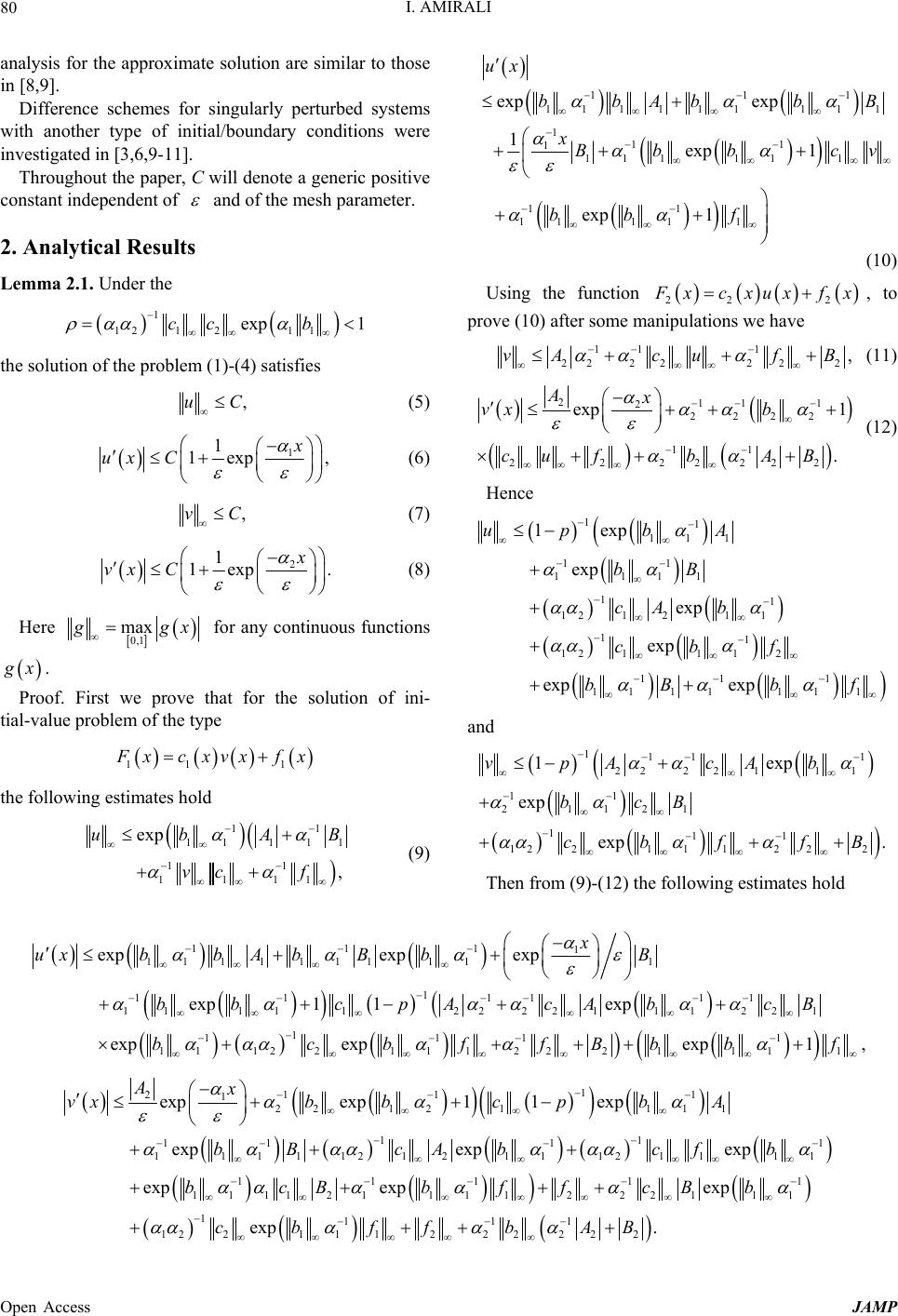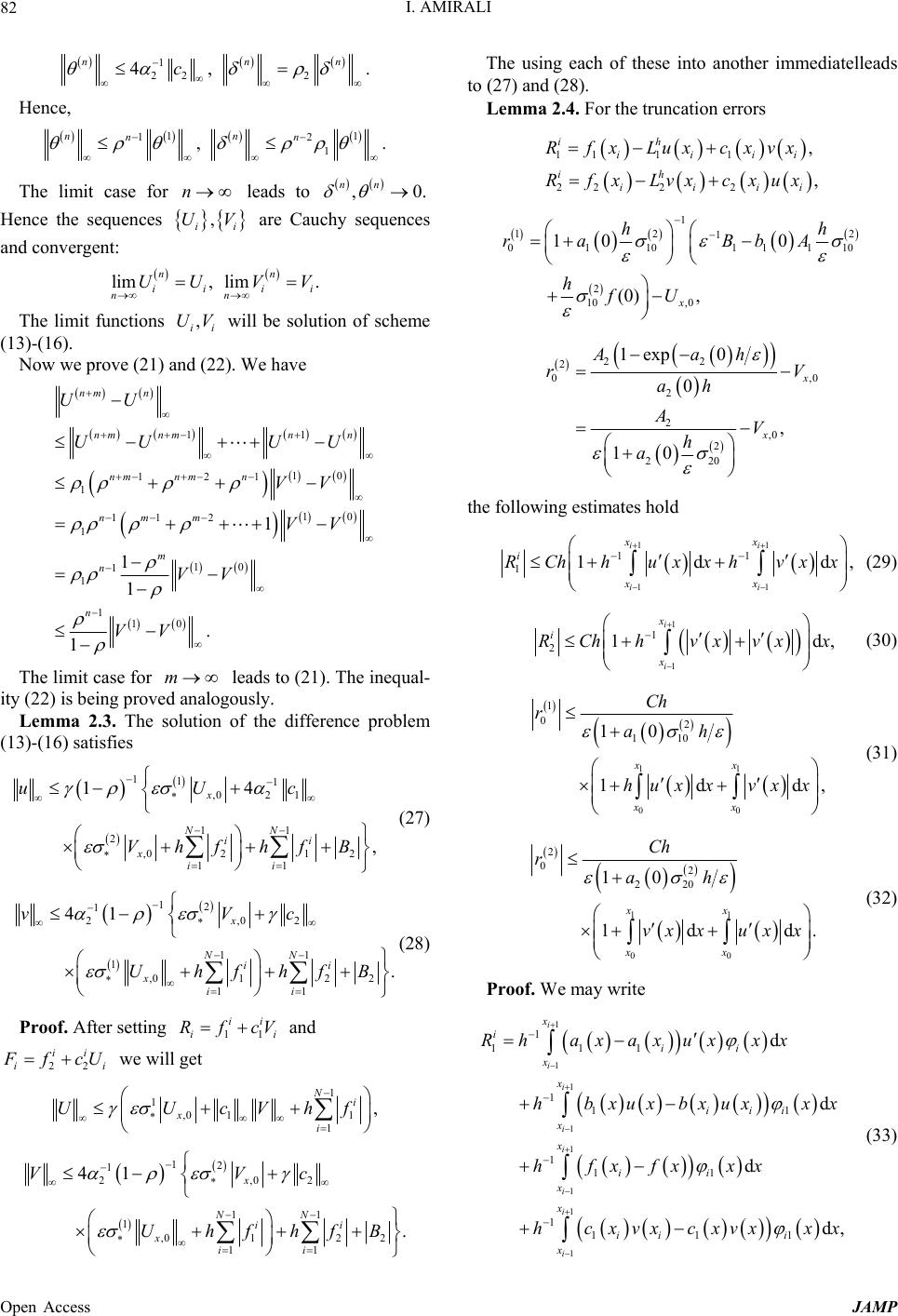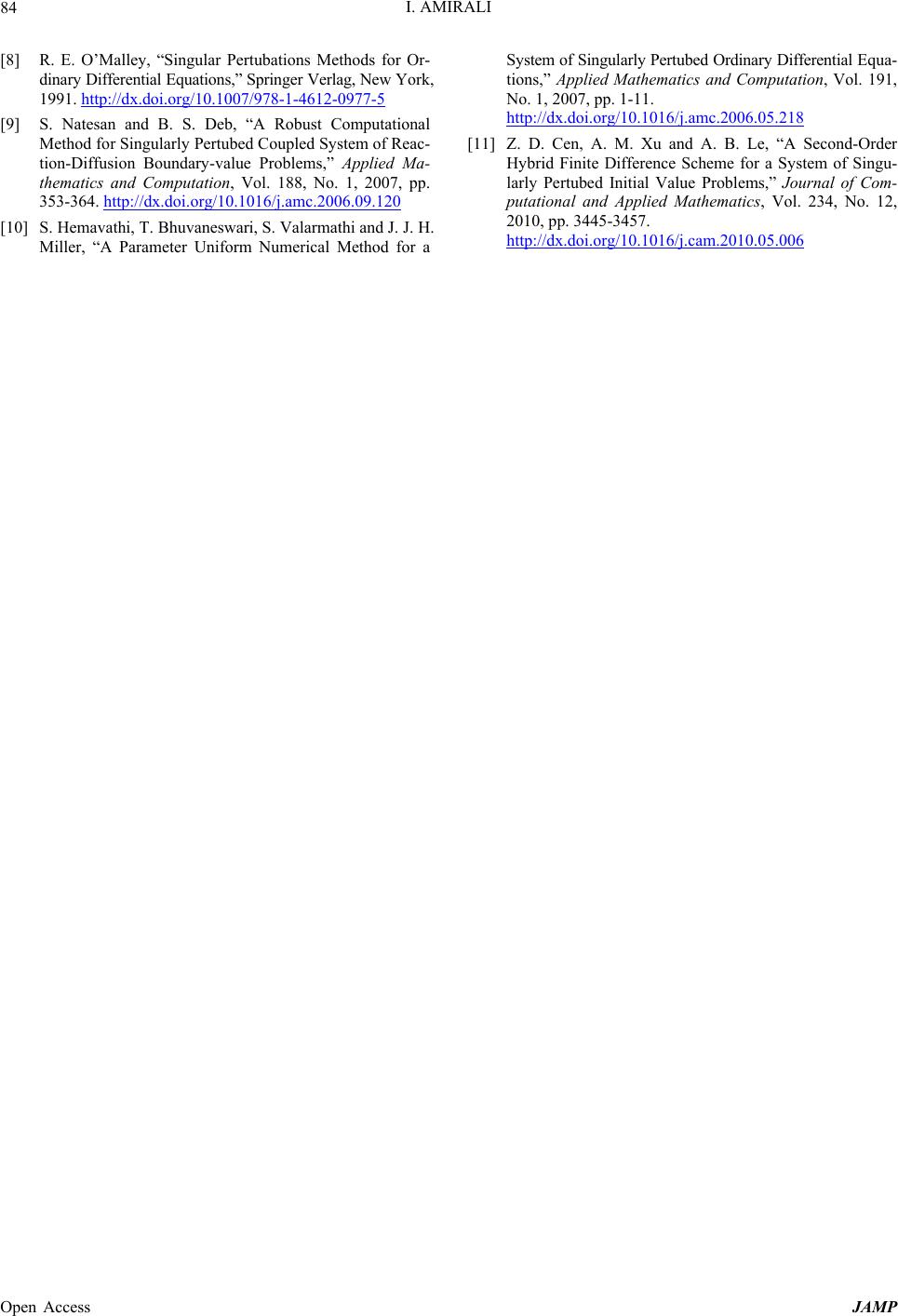 Journal of Applied Mathematics and Physics, 2013, 1, 79-84 Published Online November 2013 (http://www.scirp.org/journal/jamp) http://dx.doi.org/10.4236/jamp.2013.15012 Open Access JAMP Error Estimates for the Difference Method to System of Ordinary Differential Equations with Boundary Layer Ilhame Amirali Department of Mathematics, Faculty of Art and Science, Sinop University, Sinop, Turkey Email: ailhame@gmail.com Received August 14, 2013; revised September 15, 2013; accepted October 1, 2013 Copyright © 2013 Ilhame Amirali. This is an open access article distributed under the Creative Commons Attribution License, which permits unrestricted use, distribution, and reproduction in any medium, provided the original work is properly cited. ABSTRACT This work deals with the numerical solution of singular perturbation system of ordinary differential equations with boundary layer. For the numerical solution of this problem fitted finite difference scheme on a uniform mesh is constructed and an alyzed. The uniform error estimates for the approximate solution are ob tained. Keywords: Singular Perturbation; Linear System; Difference Scheme; Uniform Convergence; Error Estimates 1. Introduction We consider the initial-boundary value problem for the linear system of ordinary differential equations in the interval : [0,1] 111 11 : , 01, Luuax ubxu cxv fxx (1) 222 22 : , 01, Lvvax vbx v cxufx x (2) 1 1 00, B uAu , (3) 22 0, 1 A vv .B (4) where is a small parameter, 1 , 2 , , are given constants. The functions 1 B 0, 2 B ii ax x i b, , i cx i x are given functions satisfying 1, 2i certain regularity conditions will be specified whenever necessarily. The above type initial/boundary value problems arise in many areas of mechanics and physics [1,2]. Differential equations with a small parameter mul- tiplying the highest-order derivative terms are said to be singularly perturbed. They occur frequently in mathe- matical problems in the sciences and engineering for example, in fluid flow at high Reynold number, electrical networks, chemical reactions, control theory, the equa- tions governing flow in porous media, the drift-diffusion equations of semi-conductor device physics, and other physical models. The mathematical models describing these phenomena contain a small parameter and the influence of this parameter reveal itself in a sudden change of the dependent variable u taking place with in a small layer. That is, the solution of this type of problem has a narrow region in which the solution changes rapidly and the outside solution changes smooth- ly [1-3]. It is well-known that standard discretization methods do not work well for these problems as they often pro- duce oscillatory solutions which are inaccurate if the perturbed parameter is small. To obtain robust nu- merical methods, it is necessary to fix the coefficients (fitted operator methods) or the mesh (fitted mesh meth- ods) to the behavior of the exact solution [2,4]. In this present paper, we analyze the numerical solu- tion of the initial/boundary problem (1)-(4). The nu meri- cal method presented here comprises a fitted difference scheme on a uniform mesh. Fitted operator method is widely used to construct and analyse uniform difference methods, especially for a linear differential problems (see, e.g., [4-7]). In the Section 2, we state some important properties of the exact solution. The derivations of the difference scheme and uniform convergence analysis have been given in Section 3. Uniform convergence is proved in the discrete maximum norm. The approach to the construction of the discrete problem and the error  I. AMIRALI 80 analysis for the approximate solu tion are similar to those in [8,9]. Difference schemes for singularly perturbed systems with another type of initial/boundary conditions were investigated in [3,6,9-11]. Throughout the paper, C will denote a generic positive constant independent of and of the mesh parameter. 2. Analytical Results Lemma 2.1. Under the 1 12121 1 exp 1cc b the solution of the problem (1)-(4) satisfies ,uC (5) 1 1 1exp x ux C , (6) ,vC (7) 2 1 1exp . vx C (8) Here 0,1 max gx for any continuous functions x. Proof. First we prove that for the solution of ini- tial-value problem of the type 11 1 xcxvxfx the following estimates hold 11 11 111 11 1111 exp , ubA vc f 11 11111111 1 111 1111111 11 1111 1 exp exp 1exp 1 exp 1 ux bbAb bB xBbbc bb f 1 v (10) Using the function 22 2 xcxuxfx, to prove (10) after some manipulations we have 11 1 222 2222 ,vAcuf B (11) 211 1 22222 11 2222222 exp 1 . Ax vx b cu fbAB (12) Hence 11 11 1 11 1111 11 12121 1 11 1211 12 11 1 11 11111 1exp exp exp exp exp exp up bA bB cA b cb f bBb f and 111 1 222 2111 11 21121 111 1221112 22 1ex exp exp . vpAcAb bcB cbf fB p B (9) Then from (9)-(12) the following estimates hold 111 1 111 1 111111 1 1111 11 1 11112222 11122 1 1 111 1112211 12221111 expexp exp exp1 1exp expexpexp1 , x uxbb AbBbB bbcpA cAbcB bcbffBbb 1 f 1 211 1 122121111 11 11 1 11 1112121 112111 1 111 1 11112111 1222 111 1 12 21 expexp11 exp expexp exp exp expexp exp Ax vxbbc pbA bBcAbcf b bcB bffcBb cb 1 1 111 1122222 2 .ffb AB Open Access JAMP  I. AMIRALI 81 The last inequalities show the validity of (5)-(8). 3. The Difference Scheme and Convergence Now we construct the difference scheme and investigate it. In what follow, we denote by the uniform mesh in : [0,1] ,1,2,,1,1 hi ih iNhN And 0, . l Before describing our nu- merical method, we introduce some notation for the mesh functio ns . F or any mesh function g(x), we use , ii gx 1 ,, ii xi gg gh 1 ,, ii xi g gh 11 ,, 2 oii xi gg gh 11 ,2 2, iii xx i ggg gh ,,, max . i doiN gg On we propose the following difference scheme for approximating (1)-(4): 1 1,1 1 , 11 ,1,2,,1 o ii hii xxii xi ii i LUUaU bU cVf iN , (13) 2 2,2 2 , 22 ,1,2,,1 o ii hii xxii xi ii i LVVaV bV cUfiN , (14) 1 1 22 1 ,110 11 2 10 1 , 10 0 0, o xo UA h Ua Bb hf 10 h (15) 22 ,0 2 2 1exp 0 , 0 xN h Aa VV h B (16) where coth,1,2 . 22 k ikiki hh ax axk Note that 22 1, 2 kk ikiki ah where 1 1exp1 , kik i ki h ax axh 1 21exp, 1,2. kik iki h ax k axh Throughout the paper, we assume that 11 2121 11 41,4expcc b 1* . 1 i 2 i For solving of the (13)-(16), we giving the following iterative procedure: 1 11, nn i hii LU cVf (17) 22. nn i hi i LV cUf (18) 01 1 22 1 1 ,0201 1110 2 10 1 , 10 0 n n x UA ah h UBb hf A (19) 22 ,0 2 2 1exp 0, , 0 n xN Aah VV ah B (20) where is arbitrary. 0 i V Lemma 2.2. The iteration (18)-(21) is suitable for the solution of the problem (13)-(16) and the solution of the difference problem (13)-(16) satisfies 110 1, 1 n n UU VV (21) 110 . 1 n n VV VV (22) Proof. Denoting 11 11 , nnnnnn iiiiii UU VV we will have 1 11 , 2,, nn hi ii Lcn N n (23) 12 , n hi ii Lc (24) 0,0 0, nn x (25) ,0 0, 0 nn xN 1n i (26) From (23)-(26) and , it is not difficult to get 1ii Rc 1 1 11 , jj nn i ii ii hR hc and thereby 11 11 . nn c n In similar manner, from (24), (26) and 2n i ii Fc we also obtain Open Access JAMP  I. AMIRALI 82 1 22 2 4, . n nn c Hence, The using each of these into another immediatelleads to (27) and (28). Lemma 2.4. For the truncation errors 11 12 1 , . n n nn The limit case for leads to . H i The limit functions will be solution of scheme (1 d (2) n , i ,0 nn hy sequencesence the sequences i U are Cauc and convergent: lim V , lim. nn ii i nn UU VV , ii UV 3)-(16). Now we prove (21 ) an2. We have 11 10 121 1 10 11 2 1 10 1 1 110 1 1 1 . 1 nm n UU nm nmnn nm nmn nm m m n n UU UU VV VV VV VV The limit case for leads to (21). The inequal- ity alo m (22) is being proved angously. Lemma 2.3. The solution of the difference problem (13)-(16) satisfies 1 11 ,0 2 1 11 2,021 2 11 14 , x NN ii xii uUc VhfhfB (27) 12 1 2,02 11 1,012 2 11 41 . x NN ii xii vVc UhfhfB (28) Proof. After setting and 11 ii ii RfcV 22 ii ii fcU we will get 1 1,0 11 1, Ni xi UUcVh f 12 1 2,02 11 1,012 2 11 41 . x NN ii xii VVc UhfhfB 11 11, ih iii RfxLuxcxvx i 22 2 2, ih ii ii Rf xLvxcxux 2 110 2 10 ,0 0 (0) , x h A hfU 1 12 1 0110 11 10 h ra Bb 22 2 0, 2 2,0 2 220 1exp 0 0 , 10 0 x Aah rV ah AV h a the following estimates hold 11 11 11 11d ii ii xx i xx RCh huxxhvxx d, (29) 1 1 1 i x i RCh h 1 2d, i x vxvx x (30) 11 00 1 02 110 10 1d xx xx Ch rah hux xvxx (31) d, 11 00 2 02 220 10 1d xx xx Ch rah vx xux x d. (32) Proof. We may write 1 x x (33) 1 1 1 1 1 1 1 1 1 111 1 111 1111 d d d d, i i i i i i i i x iii x x iii x x ii x x ii i x Rhaxaxuxxx bxux x hfxfxxx hcxvxcxvxx 1 hb xux Open Access JAMP  I. AMIRALI 83 1 1 1 1 1 1 1 1 1 222 2 122 2 1222 1222 d d () d d, i i i i i i i i x iii x x iii x x ii x x ii i x Rh axaxvx xx hbxvxbxvxx hfxfx xx hcxuxcxux x x x (34) 1 0 1 0 1 0 1 0 1 02 110 2 1101 2 11 01 2 1101 2 101 1 10 00 d 0d 0d d, x x x x x x x x rh a bxuxbuxx ax auxxx fx fxx cxvx xx (35) 1 0 11 00 1 0 2 02 220 2 22 02 2 202202 2 202 1 10 0d d d, x x xx xx x x rh a ax avxxx bxvxxxfx xx cxux xx 2 d where (36) 1 1 11 21 11 e1 ,, e1 1e ,, 1e 0, ,. ik i ik ik i ah ik axx iki i ah ax x ik ikii ii xxx xx xxx xx The relations (33)-(36) leads immediately to (29)-(32). Theorem 2.3. Let ,, k ax , 0, kkk bxcxfx C1. Then the solution of the difference problem (13)-(16) converges uniformly in to the solution of (1)-(4) with rate Proof. Let 12 , . iiiiii zUuxzVvx Then for the errors of the approximate solution 1,2; 0, ki zki N we have , 1,1, hi i i czR iN 1 10 1 ,00 2 0, , , 0, x zz r rz 11 1i Lz 21 22 212 2,0 02 , hii ii xN Lz cz R z where are approximating errors from Le 12 120 0 ,, , ii RRr r mma 2.4. Using Lemma 2.3 we obtain 12 11 112 2 002 11 , . NN ii ii zz Cr rhfhf 1 (37) By virtue that of (29)-(32) all terms in rit-hand side of this inequality have the rate and hence the proof follows immediately RE ion Techniques,” Wiley, New York, 1993. [2] E. R. Doolan, J. J. H. Miller and W. H. A. Schilders, “ Un i- form Numerical Methods for Problems with Initia Boundary Layers,” Boole Press, Dublin, 1980. [3] I. G. Amiraliyeva, “Uniform Difference Scheme on the 2.39152 gh Oh FERENCES [1] A. H. Nayfeh, “Introductions to Pertubat l and Singulary Pertubed System,” Applied Mathematics, Vol. 3, 2012, pp. 1029-1035. http://dx.doi.org/10.4236/am.201 [4] P. A. Farrell, A. F. Hegarty, J. J. H. Miller, E. O’Riordan and G. I. Shish for Boundary /CRC, New York, H. Duru, “A Uniformly Con- kin, “Robust Computational Techniques Layers,” Chapman-Hall 2000. [5] G. M. Amiraliyev and vergent Finite Difference Method for a Initial Value Pro- blem,” Applied Mathematics and Mechanics, Vol. 20, No. 4, 1999, pp. 363-370. http://dx.doi.org/10.1007/BF02458564 [6] G. M. Amiraliyev, “The Convergence of a Finite Dif- ference Method on Layeradapted Mesh for a Singulary Pertubed System,” Applied Mathematics tion, Vol. 162, No. 3, 2005, pp. 1023-1034and Computa- . http://dx.doi.org/10.1016/j.amc.2004.01.015 [7] H. G. Roos, M. Stynes and L. Tobiska, “Numerical Me- thods for Singulary Pertubed Differential Equations, Con- vection Diffusion and Flow Problems,” Springer-Verlag, Berlin, 1996. http://dx.doi.org/10.1007/978-3-662-03206-0 Open Access JAMP  I. AMIRALI Open Access JAMP 84 tions,” Springer Verlag, New Yor k 612-0977-5 [8] R. E. O’Malley, “Singular Pertubations Methods for Or- dinary Differential Equa 1991. , http://dx.doi.org/10.1007/978-1-4 1, 2007, pp. .09.120 [9] S. Natesan and B. S. Deb, “A Robust Computational Method for Singularly Pertubed Coupled System of Reac- tion-Diffusion Boundary-value Problems,” Applied Ma- thematics and Computation, Vol. 188, No. 353-364. http://dx.doi.org/10.1016/j.amc.2006 [10] S. Hemavathi, T. Bhuvaneswari, S. Valarmathi and J. J. H. Miller, “A Parameter Uniform Numerical Method for a System of Singul arly Pertubed Or dinary Differential E qu a- tions,” Applied Mathematics and Computation, Vol. 191, No. 1, 2007, pp. 1-11. http://dx.doi.org/10.1016/j.amc.2006.05.218 [11] Z. D. Cen, A. M. Xu and A. B. Le, “A Second-Order Hybrid Finite Difference Scheme for a System of Singu- larly Pertubed Initial Value Problems,” Journal of Com- putational and Applied Mathematics, Vol. 234, No. 12, 2010, pp. 3445-3457. http://dx.doi.org/10.1016/j.cam.2010.05.006
|